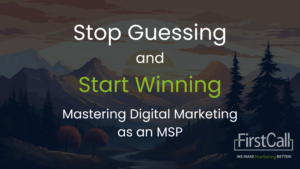Have you seen the movie Sing? It\’s a cute animated movie about a koala named Buster Moon, who is trying to save his failing theater, so he puts on a singing competition show to attract talent and attention. His faithful assistant, Miss Crawly, an iguana (whose glass eye pops out and bounces to type extra zeros to the grand prize dollar amount on the flier!), is in charge of getting the word out about the show. She prints the flier on \”every single sheet of paper\” and holds the giant stack of hundreds of fliers when her fan turns and blows them all out her window and into the streets below. Buster Moon replies, \”Well, I guess that\’s one way to spread the word.\”
Buster is correct; printing hundreds of fliers and tossing them to the wind is one way to get the word out about your business. However, here at FirstCall Web, we suggest some more practical approaches to marketing to your target audience than the tactic Miss Crawley took.
Read more about our marketing strategies for small business owners that will help you identify your target market and use your marketing budget effectively.
Who is my target market?
Chances are you already have the answer to who your target market is in your customer information, whether you realize it or not. Start by looking at your sales and customer database and looking for trends or similarities. Let your data talk to you! Look for things like city and state – are your customers based in the same city as your business? If so, you can target local customers and not waste money on advertising in other areas. If you don\’t have a customer database, start taking note of who your customers are. If you are a coffee shop owner, look at your patrons in your shop – are they younger, middle-aged, or older? Are they male or female? Do you see parents with kids or college kids studying?
As a small business marketing agency, FirstCall Web can help you identify your target market if you are struggling with defining your key audience.
Small Business Advertising
Once you identify your target market, you can begin diving into digital marketing for small businesses. Each target market is looking for information in different places, so it\’s essential to know who your target market is so you can put your message in the right place. For example, if you\’re a business that has a predominantly older customer base, then it would be a complete waste of your time to be on TikTok (although we wouldn\’t mind seeing a funny video of you dancing). Spend some time researching the marketing preferences of your target audience demographic as it typically varies for each audience.
Below are three advertising avenues that are safe bets for small business owners to explore and more efficient than chucking fliers out your window.
Social Media
Social media is a powerful place for small business advertising. However, as mentioned before, knowing your target customer and what social media those customers use is vital. You could dump hundreds of hours a month on all social media platforms and only see a minimal return. Instead, we recommend developing a strategic plan for quality social media content for 1-3 platforms based on the top platforms your customers are using. Is the majority of customers between 35-and 44 years old? Then Facebook needs to be a priority. Do you have slightly younger customers, anywhere between 18-and 34 years old? Then you should look into if Instagram is a good fit for your brand. However, if you want to reach working professionals, LinkedIn is your sweet spot. However, simply launching your social profile doesn\’t mean you will be successful. You need to dedicate time for consistent posting and quality content that your customers find meaningful. Social media also provides other avenues of reach besides just having a profile. You can also pay for sponsored posts and ad campaigns. Other small business growth ideas on social media that are free are posting on Facebook Marketplace, joining buying and selling groups and posting your services in various groups.
SEO
Search Engine Optimization or SEO is how easy it is for search engines like Google to find information on your website and use it to answer search inquiries. (Read more for an SEO crash course) SEO is best achieved by continually producing quality content containing essential keywords your customers use in searches. You can do this by having a blog on your website and becoming a resource for your customers. Going back to the coffee shop example, having a blog with articles about customers\’ top three drinks from your shop, or a story from you about why you love coffee and started the coffee shop in Missoula provides you ample opportunity to work in keywords that will show up in searches. SEO is also effective when you have relevant keywords that are not too vague. For example, as a coffee shop owner, targeting \”coffee\” or \”coffee shop\” may not help you much in Google rankings because a wide variety of information shows up for generic terms. If you google just \”coffee shop,\” some local coffee shops show up, but so does a site for a game, a movie and a Wikipedia listing defining \”coffee shop.\” A better SEO strategy would target keywords like \”coffee shop in Missoula\” or \”best coffee in Missoula.\” This establishes the audience better as people looking for coffee in Missoula and not someone searching for the 2014 movie Coffee Shop starring Laura Vandervoort.
Google Ads
Along with SEO, Google Ads can be a helpful marketing tool for businesses wanting to show up higher in search results. If you Google something like \”coffee to buy online,\” you will notice that the first two website listings look like typical results, except they have a bold \”Ad\” at the beginning of the listing. The first two companies paid to target keywords about buying coffee online and created a campaign around it to get their name to show up higher than the organic results. Google ads are solid advertising because you get tracking and campaign results, so you can see how many people saw your ad and clicked on it (instead of hoping someone saw your flier in the gutter and came to your shop). Jump over to our tutorial (https://firstcall-web.com/google-ads-explained-for-small-business-owners/) to get started on Google ads, or contact us about helping you manage your campaigns.
While it makes for a cute scene in a children’s movie, leaving your advertising up to the wind is not best marketing practices. However, by looking at your customer information, developing target markets around those customers and advertising in the places those customers are looking, will have you well on your way to your grand prize.





